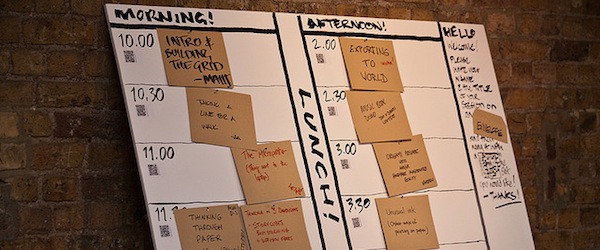Last month, Film Independent began a series of education events called “Know Your Crew,” for which we bring in industry professionals with different jobs on a crew and they explain in detail what their role is working on set. The first of these events was about the first assistant director, or first AD, and Chris Debenedetto, whose credits include Earth to Echo and TV series The Fosters, came in to talk about his job. The first AD is a facilitator and manager, but also right-hand man to the director. He or she doesn’t just get hired based on credentials—personality and chemistry with the director are important, even though this isn’t one of the more creative roles. The first AD is one of the earliest people to get hired, but mostly when a project is about to start production, or about to start really prepping. “Every time you come onto a project as an AD, they’re going to hand the schedule to you,” Debenedetto said. “That’s your thing.” The first AD essentially runs the set, and that starts with scheduling everything. At the very beginning, the first AD goes through the script and breaks it down to its nuts and bolts during pre-production, then determines the best way to go about shooting it efficiently. The basic principles of scheduling are incredibly complicated. A scene at night, for example, creates all kinds of problems, and shooting with children can be a logistical nightmare. There are so many factors to scheduling: how many/which characters are needed, whether any are minors, the time of day and location needed (Thankfully, there’s scheduling software to help sort it all out.) Though internalizing the schedule and having an innate understanding of how long things will take is the responsibility of the first AD, those same skills make for a better director, as well, Debenedetto said. Their first day working together, the director and the AD should go over everything; then the AD can implement the director’s vision into his plan. “A director’s a director,” Debenedetto said. “A director’s a very creative person, and they have every right to ask for everything that they want—but they also don’t always know how to accomplish those goals and what it’s going to cost to accomplish those goals.” While the schedule is in the AD’s hands, most budgeting falls to the line producer. The duration of production, however, has a major impact on the budget, and that’s the AD’s job to figure out. Underneath the AD, on his team, are a second AD, and then a second second, and PAs work under them. The second AD deals with talent a lot of the time; a good way to think of it is that the first deals with today, while the second deals with tomorrow. While on the set, the first AD’s job is, simply put, to make the day. “Nobody really knows what the hell is going on on a set,” Debenedetto said. “Everyone’s in charge of their own thing, but as a collective, nobody knows every single thing that’s happening—except for the first. Once the roller coaster starts, it’s really hard to stop it. You want to keep the flow, you want to keep the energy, and that’s what we do.” While keeping production running smoothly and making sure the set is a positive work environment, the AD also works to keep the director calm and focused: “The director has a lot on his plate,” Debenedetto noted, “He’s the one making all these creative decisions. He’ll probably get 300, no joke, questions a day about nonsense, but important nonsense. But a lot of that stuff comes to the first AD, so you try to shield the director as much as you can.” When someone asked about the relationship between the DP and the first AD, Debenedetto, half-joking, called it “volatile.” He then amended, “the DP is a creative manager. So that’s tough. They have to make something look very beautiful, but have no time to do it…But the DP is [also] the first person to tell me ‘oh, thank god you’re here,’ because they know that the AD knows how to make a movie. That’s the one thing we know how to do—we know the nuts and bolts of making a film.” Mary Sollosi / Film Independent Blogger
